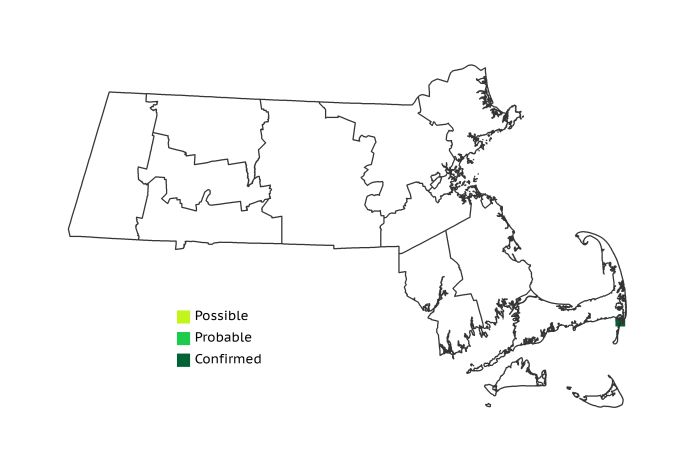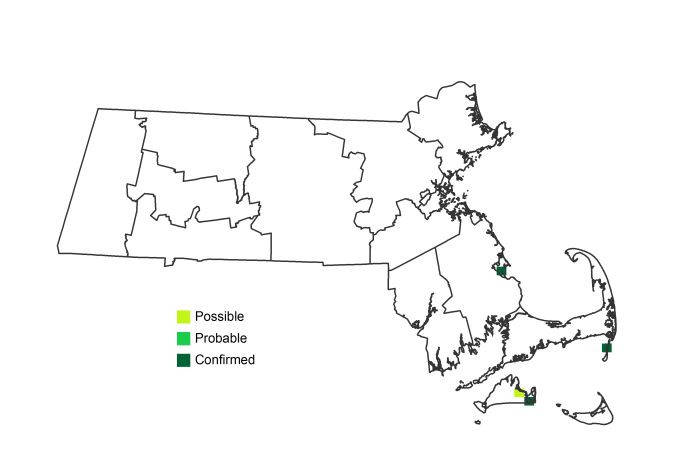Find a Bird
Black Skimmer
Rynchops niger

Very local, trend not established
“With their extraordinary lower mandibles, a third longer than the upper ones, and held almost at right angles to their necks, the skimmers were colorful, irresistible, unforgettable.” – Roger Tory Peterson and James M. McConnell Fisher, Wild America
The Black Skimmer is an anatomically unusual bird, and its surface-skimming feeding strategy is practically unique. The Black Skimmer’s coal-black back and long lower mandible further contributes to making it one of our most unmistakable coastal species. Skimmers nest colonially and often in association with terns, possibly to benefit from the terns’ vigilance and aggressive persistence against predators. Unfortunately, this strategy failed when tern colonies became the prime targets of plume hunters and egg collectors during the late nineteenth century.
Historic Status
Black Skimmers greeted Samuel de Champlain as he investigated what would one day become the coast of Massachusetts in July 1605 (Forbush 1925). They have engaged in an on-again off-again relationship with the state ever since, with spotty breeding records mirroring their seemingly languid attitude. There is a circuitous story, reported by Henry A. Purdie, that William Brewster had been told the species was nesting on Nantucket's Muskeget Island in the 1830s. Purdie also quoted Cape Cod residents of the 1830s as saying “them cutwater or shearwater birds used to be with us summer times” (Forbush 1925). Forbush goes on to suggest that the species may have then been extirpated by eggers, a fate he reported they met along the east coast. Breeding in Massachusetts resumed in 1946, and continued erratically into the period of Atlas 1.
Atlas 1 Distribution
Black Skimmers turn up in Massachusetts most frequently at tern colonies in areas with natural protection from predators, such as islands or barrier beaches. Their breeding appearances in Massachusetts have always been unpredictable, but fortunately one such appearance was made during the Atlas 1 period at Monomoy Island in 1976. No other signs of breeding skimmers were found during Atlas 1, but fortunately this odd-billed species would return in future years.
Atlas 2 Distribution and Change
While still a rare breeder in the state, the Black Skimmer was Confirmed in 3 blocks during Atlas 2. Massachusetts represents the northern edge of this species’ breeding range, and forays into the state by potential breeders are a rare but regular occurrence. Their somewhat irruptive behavior, even to our south makes any trend estimation difficult, but the species represents a welcome addition to the community of beach-nesting birds.
Atlas 1 Map

Atlas 2 Map

Atlas Change Map

Ecoregion Data
Atlas 1 | Atlas 2 | Change | ||||||
Ecoregion | # Blocks | % Blocks | % of Range | # Blocks | % Blocks | % of Range | Change in # Blocks | Change in % Blocks |
Taconic Mountains | 0 | 0.0 | 0.0 | 0 | 0.0 | 0.0 | 0 | 0.0 |
Marble Valleys/Housatonic Valley | 0 | 0.0 | 0.0 | 0 | 0.0 | 0.0 | 0 | 0.0 |
Berkshire Highlands | 0 | 0.0 | 0.0 | 0 | 0.0 | 0.0 | 0 | 0.0 |
Lower Berkshire Hills | 0 | 0.0 | 0.0 | 0 | 0.0 | 0.0 | 0 | 0.0 |
Vermont Piedmont | 0 | 0.0 | 0.0 | 0 | 0.0 | 0.0 | 0 | 0.0 |
Berkshire Transition | 0 | 0.0 | 0.0 | 0 | 0.0 | 0.0 | 0 | 0.0 |
Connecticut River Valley | 0 | 0.0 | 0.0 | 0 | 0.0 | 0.0 | 0 | 0.0 |
Worcester Plateau | 0 | 0.0 | 0.0 | 0 | 0.0 | 0.0 | 0 | 0.0 |
Lower Worcester Plateau | 0 | 0.0 | 0.0 | 0 | 0.0 | 0.0 | 0 | 0.0 |
S. New England Coastal Plains and Hills | 0 | 0.0 | 0.0 | 0 | 0.0 | 0.0 | 0 | 0.0 |
Boston Basin | 0 | 0.0 | 0.0 | 0 | 0.0 | 0.0 | 0 | 0.0 |
Bristol and Narragansett Lowlands | 0 | 0.0 | 0.0 | 0 | 0.0 | 0.0 | 0 | 0.0 |
Cape Cod and Islands | 1 | 0.7 | 100.0 | 4 | 2.8 | 100.0 | 3 | 2.5 |
Statewide Total | 1 | 0.1 | 100.0 | 4 | 0.4 | 100.0 | 3 | 0.4 |



